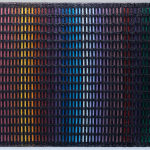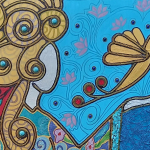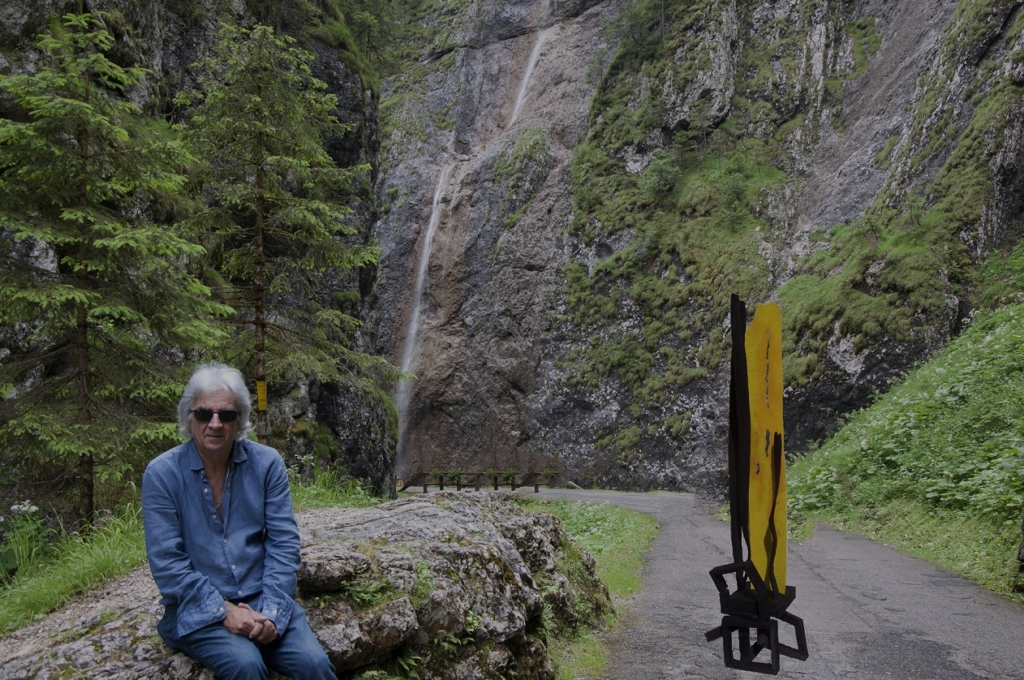
La caratteristica delle persone costantemente in movimento, che accettano di compiere delle trasformazioni radicali della propria esistenza, che non esitano a cambiare completamente città, modo di vivere e realtà sociale se le condizioni lo richiedono, presentano la caratteristica comune di essere da un lato perfettamente calate nel momento presente, proiettate verso un domani possibile e concreto, dall’altro però non possono fare a meno di guardarsi indietro per considerare e osservare tutto ciò che è stato lasciato alle spalle, quelle differenti occasioni che avrebbero potuto avere se avessero compiuto scelte differenti. Questo è esattamente l’approccio alla vita e alla creatività di Giancarlo Mariniello, nomade per inclinazione e determinato nella scelta di ciò che è il meglio per sé ma al tempo stesso consapevole di aver dovuto compiere delle rinunce, di aver rivoluzionato la sua esistenza che si svolge attualmente a metà tra l’Italia, dove sono i suoi affetti familiari, e la Romania, nazione in cui lavora ricoprendo un ruolo dirigenziale in un’importante azienda locale. Tuttavia il successo professionale e l’impossibilità di restare fermo in un solo luogo non gli impediscono di porsi molto spesso in posizione di ascolto di se stesso, della propria interiorità che trova sfogo e voce espressiva nell’arte, quasi come se in qualche modo si mettesse a nudo nell’atto creativo, connettendosi con le sue profondità in quel magico momento in cui la materia si trasforma gradualmente in mezzo comunicativo. L’opera di Giancarlo Mariniello si sofferma a lungo sul concetto del tempo osservato da diverse angolazioni e narrato attraverso sfaccettature differenti, a volte in maniera più malinconica, altre più ossessiva, altre più nostalgica nei confronti di tutto ciò che è stato perduto nel corso dell’esistenza; così come diversa è la tecnica utilizzata per realizzare le sue opere, sempre fortemente tendenti all’Informale e alcune volte più materiche, dunque lasciando interagire la pittura e i colori con materiali di riciclo come stralci di juta, elementi in legno o metallici, mentre in altri casi preferisce rimanere sulla bidimensionalità lasciando alle tonalità intense la facoltà di raccontare il suo stato d’animo. Malgrado l’ampio utilizzo del colore nero e della scala di grigi, le sue opere sembrano sempre pervase dalla luce dell’interiorità, come se l’artista volesse suggerire che malgrado la cupezza della malinconia, del rimpianto o, in alcuni casi, del rimorso, esiste sempre una luminosità di fondo che è quella legata alla capacità dell’individuo di comprendere, di evolvere esattamente in virtù degli errori commessi, degli amori perduti, delle occasioni mancate o lasciate andare nella convinzione di poterle riafferrare una prossima volta. Una prossima volta che però non c’è mai stata, non si è presentata, e grazie a quell’assenza ha insegnato a osservare il tempo in maniera inedita, non più come qualcosa che si può anche perdere o lasciar andare bensì come qualcosa da afferrare e vivere nella pienezza. Questo è il senso dell’opera Il tempo non trascorso
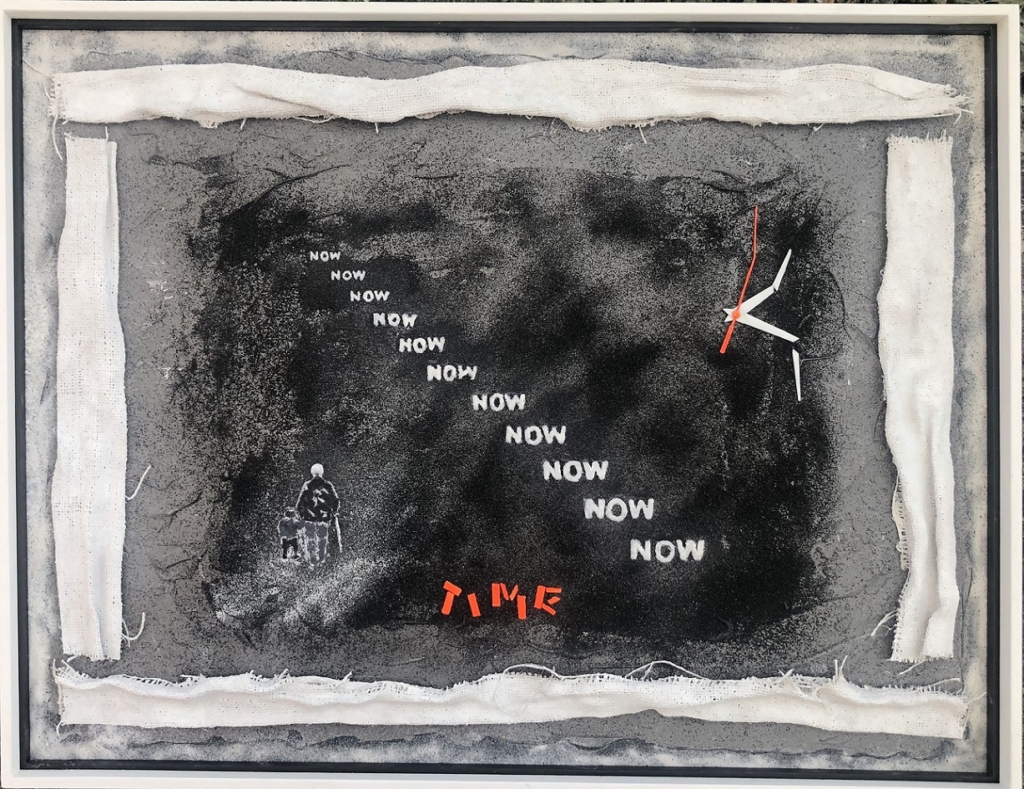
in cui la parola now, adesso, viene ripetuta ossessivamente per sottolineare quanto tutto ciò che in fondo conta sia il momento presente, perché la vita è una somma di momenti presenti. Il futuro non è concreto, non si può vivere poiché non è ancora giunto mentre il passato allo stesso modo non può più tornare e dunque tutto ciò che resta è una serie infinita di istanti che si uniscono allo scandire delle lancette rotte poste in un angolo della composizione, monito nei confronti di eventuali future distrazioni. Di forte impatto emozionale è la tela Le lacrime che non ho pianto,
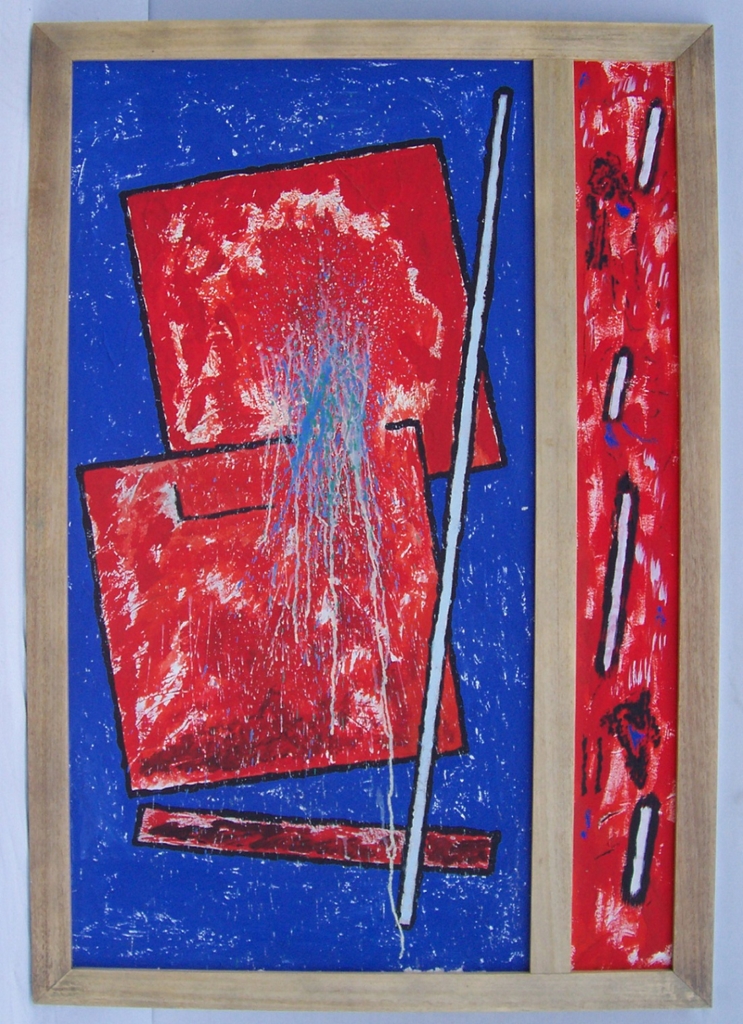
che racchiude nel titolo stesso il senso di quelle tonalità intense del rosso e dell’azzurro che sembrano rappresentare il primo il colore di un dolore troppo a lungo inespresso e lasciato nell’intimità dell’animo, il secondo la vita che continuava a scorrere intorno malgrado le ferite continuassero a sanguinare silenziose. L’elemento materico, il legno, sembra costituire una netta divisione tra ciò che è restato nascosto e l’apparenza che invece era necessario dare al mondo esterno. Andiamo ora a scoprire di più di questo particolare artista.
Giancarlo, la sua vita è piuttosto movimentata tra gli impegni professionali, gli spostamenti e la necessità interiore di dedicarsi all’arte. Come riesce a trovare lo spazio per fare tutto? Quanto hanno inciso le sue esperienze passate sulla consapevolezza di dover trovare il tempo per fare ciò che ama?
In realtà sento sempre di non avere abbastanza tempo per fare tutto ciò che vorrei, la mia creatività avrebbe bisogno di esprimersi almeno una volta alla settimana ma mi rendo che a malapena riesco a realizzare un’opera al mese perché devo dare la precedenza agli altri impegni professionali e personali. Il lavoro ha ritmi intensi e molto alti tra l’altro prevede anche aggiornamenti costanti, altrimenti rischio di restare indietro e non recuperare più e poi leggere e aggiornarmi prevede un ulteriore impegno di lavoro ma extra lavoro, dunque devo dare la priorità a questa parte della mia vita; però dal passato ho imparato a ritagliarmi degli spazi per dare sfogo alla creatività altrimenti lasci trascorrere i mesi e gli anni senza aver fatto ciò che vuoi davvero.
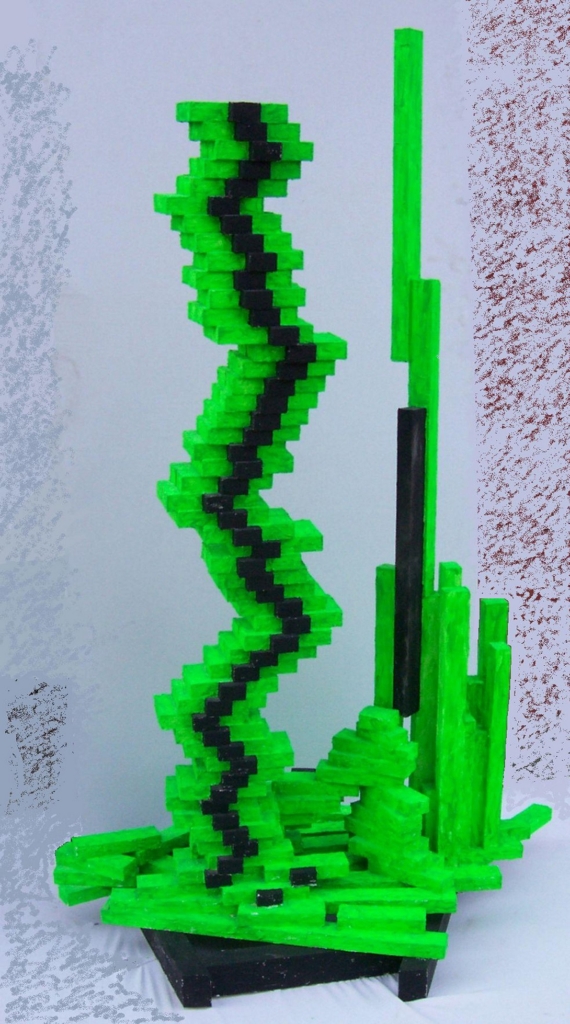
Perché il tema del tempo è così dominante nella sua produzione artistica? Qual è il messaggio che desidera lasciare agli osservatori delle sue opere? Crede che nella contemporaneità le persone tendano a perdere il contatto con l’esigenza di fermarsi e assaporare ciò che fa parte del presente?
Da sempre penso che nessuno di noi sa quanti anni ha, se guardo l’orologio aspettando che passi un minuto ci vuole molto, se scherzo in una conversazione il tempo si restringe, se guardo il sorriso di un bimbo il tempo si ferma. Quanti anni ho? Credo che ogni opera, creazione, evento, susciti un’emozione in chi la vede, un regalo non materico… dunque mi auguro sempre che quello che faccio metta in subbuglio, anche labile, il mondo interiore di chi guarda l’opera e quando realizzo di esserci riuscito mi sento appagato, sento di aver raggiunto il mio obiettivo. Anche perché nella società contemporanea non c’è mai tempo o forse l’uomo moderno non si sa organizzare, non so. A volte sogno di andare in un tempio Shaolin perché immagino che il tempo in quei luoghi scorra con ritmi interiori profondamente diversi partendo dal nostro mondo per fuoriuscire poi verso l’esterno. Il tempo è l’intensità vorrei che tutti fossero in grado di capire l’importanza di viverlo a pieno.
Il suo stile è Informale ma soprattutto orientato al riutilizzo di materiali che trova per caso, o che invece va a ricercare, e con cui dà corpo alla sensazione che sta vivendo nel momento della creazione. A cosa è dovuta la scelta di questo approccio artistico? Nasce prima l’idea del concetto oppure è la materia che le suggerisce quale corpo darle e quale messaggio affidarle?
Ritengo di aver avuto la fortuna di aver imparato in maniera autodidatta a lavorare il legno, il ferro e le resine, tra bricolage e artigianato ho acquisito molta manualità pur cosciente dei limiti della mancanza di una formazione specifica, in piccola parte recuperati studiando, leggendo e approfondendo e questo mi ha permesso di spaziare tra interior design, sculture e quadri che non pensavo di riuscire a realizzare. Eppure i risultati dei miei tentativi hanno iniziato a piacermi molto così non mi sono più fermato. Per quanto riguarda l’approccio creativo invece a volte nasce prima l’idea e altre è la materia con cui opero a suggerirmi il messaggio, in alcuni casi sembra quasi che ambedue i concetti si rincorrano come flash istantanei poi memorizzati e messi in opera.
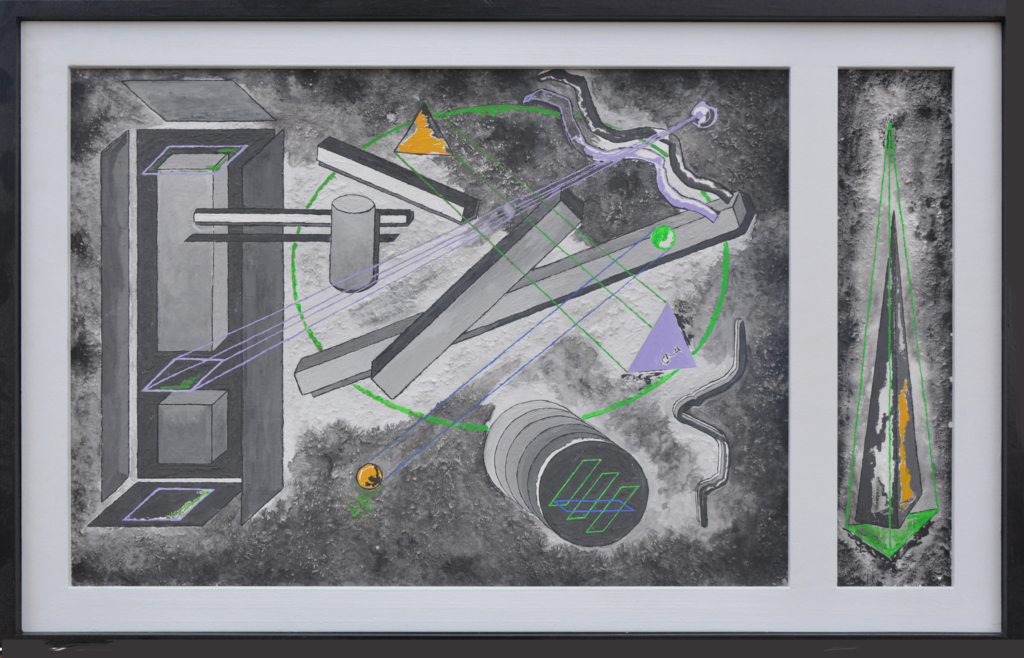
Una delle sue produzioni di maggiore successo è stata la serie degli orologi artistici, ce ne vuole parlare? Quali sono i materiali che ha usato per produrre i pannelli che li costituiscono?
Il lavoro lontano da casa prevede delle privazioni, anche molto grandi, e se non sei predisposto a fare sacrifici non puoi farlo; arrivare in un paese straniero, senza conoscere la lingua, da solo, un conoscente, poco dopo il trasferimento, mi chiese cosa facessi dopo il lavoro e io risposi che in quel luogo era necessario inventarsi dei modi per occupare il tempo libero. Qualche giorno dopo nacque il primo orologio con struttura in legno, resina e colorato; avevo iniziato ad inventare il mio tempo e da allora ho continuato a realizzare orologi in pietra, in ferro, variando le forme iniziali di quelli originari in legno. La prima esposizione è arrivata dopo pochi mesi e ha avuto un impatto molto positivo così ho pensato di donare il ricavato in beneficenza. Era quello che sentivo di fare e non ho esitato.
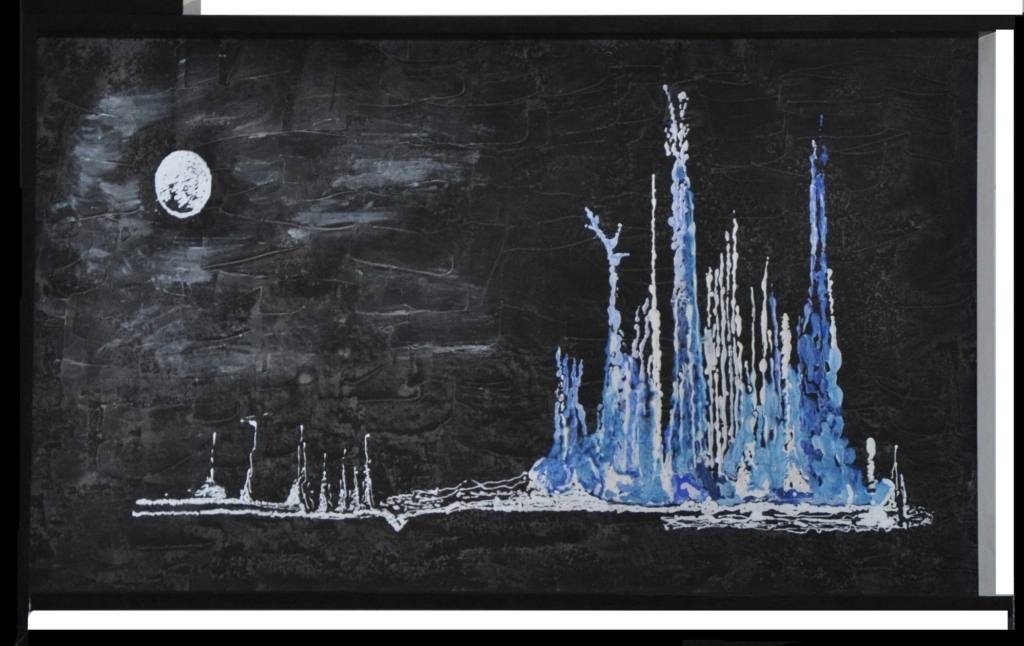
Ultimamente ha partecipato a diverse mostre collettive, in Italia e all’estero, e ha recentemente concluso una personale a Roma. Ci racconta i suoi prossimi progetti?
Non riesco a programmare nel dettaglio, dati gli impegni, mi oriento in funzione dei miei spazi, ma non vorrei tralasciare tutte le occasioni che mi capitano tra mostre ed eventi. Cerco di non avere aspettative anche perché se per qualche motivo non riesco a realizzare ciò che desidero, resto deluso perciò tutto quello che accade lo vedo come qualcosa in più!! Comunque vorrei ripercorrere l’iter delle mostre europee e anche in Italia, soprattutto nella mia regione dove ho fatto poco… Vediamo, sarà ancora una volta il tempo a decidere.
GIANCARLO MARINIELLO-CONTATTI
Email: office@frammenti1989.eu
Sito web: www.frammenti1989.eu
Facebook: https://www.facebook.com/frammenti1989
Marta Lock’s interviews: Giancarlo Mariniello, the concept of time as the basis of his artistic research
People who are constantly on the move, who accept to make radical transformations in their existence, who do not hesitate to completely change city, way of life and social reality if conditions require it, have the common characteristic of being, on the one hand, perfectly immersed in the present moment, projected towards a possible and concrete tomorrow, but on the other hand they cannot help but look back to consider and observe everything that has been left behind, those different opportunities that they could have had if they had made different choices. This is exactly Giancarlo Mariniello’s approach to life and creativity, a nomad by inclination and determined in choosing what is best for himself, but at the same time aware of having had to make sacrifices, of having revolutionised his existence, which currently takes place halfway between Italy, where his family affections are, and Romania, where he works in a managerial role in an important local company. However, his professional success and the impossibility of staying still in one place do not prevent him from very often placing himself in a position of listening to himself, to his inner self that finds vent and expressive voice in art, almost as if he were somehow laying himself bare in the creative act, connecting with its depths in that magical moment when matter is gradually transformed into a communicative medium. Giancarlo Mariniello’s work dwells at length on the concept of time observed from different angles and narrated through different facets, sometimes in a more melancholic manner, sometimes more obsessive, sometimes more nostalgic towards all that has been lost in the course of existence; just as different is the technique used to realise his artworks, always strongly tending towards the Informal and sometimes more material, thus allowing the paint and colours to interact with recycled materials such as scraps of jute, wooden or metal elements, while in other cases he prefers to remain two-dimensional, leaving the intense tones to tell his state of mind. Despite the extensive use of black colour and greyscale, his artworks always seem to be pervaded by the light of interiority, as if the artist wished to suggest that despite the gloom of melancholy, regret or, in some cases, remorse, there is always an underlying luminosity that is linked to the individual’s ability to understand, to evolve precisely by virtue of the mistakes made, the loves lost, the opportunities missed or let go in the conviction that they can be regained next time. A next time that, however, has never been, has not occurred, and thanks to that absence has taught us to observe time in a new way, no longer as something that can be lost or let go of but as something to be grasped and experienced in its fullness. This is the meaning of the work The time not spent in which the word now is repeated obsessively to emphasise how all that matters in the end is the present moment, because life is a sum of present moments. The future is not concrete, it cannot be lived because it has not yet arrived, while the past similarly cannot return, and therefore all that remains is an infinite series of instants that are joined by the sound of broken hands placed in a corner of the composition, a warning against possible future distractions. Of strong emotional impact is the canvas The Tears I Have Not Wept, which contains in the title itself the sense of those intense shades of red and blue that seem to represent the first the colour of a pain too long unexpressed and left in the intimacy of the soul, the second the life that continued to flow around despite the wounds continuing to bleed silently. The material element, wood, seems to constitute a clear division between what remained hidden and the appearance that needed to be given to the outside world. Let us now discover more about this particular artist.
Giancarlo, your life is quite eventful between professional commitments, travelling and the inner need to dedicate yourself to art. How do you find the space to do it all? How much have your past experiences affected your awareness of having to find time to do what you love?
Actually I always feel that I do not have enough time to do everything I would like, my creativity would need to express itself at least once a week but I realise that I barely manage to produce one artawork a month because I have to give priority to other professional and personal commitments. My work has an intense and very high pace and also involves constant updating, otherwise I risk falling behind and not catching up, and then reading and updating involves further work but outside of work, so I have to give priority to this part of my life; however, from the past I have learnt to carve out spaces to give vent to creativity otherwise you let months and years go by without having done what you really want.
Why is the theme of time so dominant in your artistic production? What is the message you wish to leave to the viewers of your artworks? Do you think that in the contemporary world people tend to lose touch with the need to stop and savour what is part of the present?
I have always thought that none of us knows how old we are, if I look at the clock waiting for a minute to pass it takes a long time, if I joke in a conversation time shrinks, if I look at a child’s smile time stops. How old am I? I believe that every work, creation, event, arouses an emotion in those who see it, a non-material gift… so I always hope that what I do stirs up the inner world of the ones who look at the artwork, even the faintest one, and when I realise that it has happened, I feel fulfilled, I feel that I have achieved my goal. Also because in today’s society there is never time or perhaps modern man does not know how to organise himself, I don’t know. Sometimes I dream of going to a Shaolin temple because I imagine that time in those places flows with profoundly differences, inner rhythms starting from our world and then flowing outwards. Time is intensity I would like everyone to be able to understand the importance of living it to the full.
Your style is Informal but above all oriented towards the reuse of materials that you find by chance, or that you go searching for, and with which you give substance to the feeling you are experiencing at the moment of creation. What is the reason for choosing this artistic approach? Does the idea of the concept come first, or is it the material that suggests which body to give it and which message to entrust to it?
I believe I have been lucky enough to have been self-taught in working with wood, iron and resins. Between DIY and handicrafts, I have acquired a lot of manual dexterity while being aware of the limits of the lack of specific training, which I have recovered in small part by studying, reading and studying in depth. Yet I began to like the results of my attempts very much, so I have not stopped since. As far as my creative approach is concerned, sometimes the idea comes first and sometimes it is the material I work with that suggests the message to me, in some cases it almost seems as if both concepts run after each other like instantaneous flashes that are then memorised and put into action.
One of your most successful productions was the series of artistic clocks, would you like to tell us about it? What materials did you use to produce the panels that make them up?
Working away from home involves hardship, even great hardship, and if you are not prepared to make sacrifices, you cannot do it; arriving in a foreign country, without knowing the language, alone, a friend, shortly after moving there, asked me what I did after work and I replied that in that place it was necessary to invent ways to occupy your free time. A few days later the first clock with a wooden, resin and coloured structure was born; I had begun to invent my time and since then I have continued to make clocks in stone, iron, varying the initial shapes of the original wooden ones. The first exhibition came after a few months and had a very positive impact so I thought of donating the earnings to charity. It was what I felt like doing and I did not hesitate.
Lately you have participated in several group exhibitions, in Italy and abroad, and you recently concluded a solo exhibition in Rome. Can you tell us about your next projects?
I can’t plan in detail, given my commitments, I orient myself according to my space, but I don’t want to miss all the opportunities that come my way between exhibitions and events. I try not to have expectations also because if for some reason I don’t achieve what I want, I am disappointed so I see everything that happens as something extra! However, I would like to go through the process of European exhibitions and also in Italy, especially in my region where I have done very little… Let’s see, once again time will decide.

